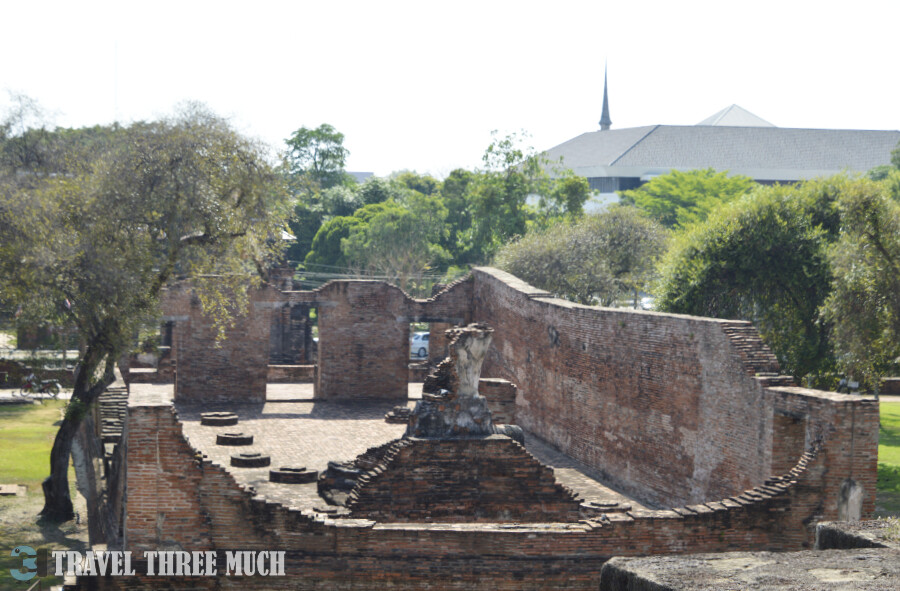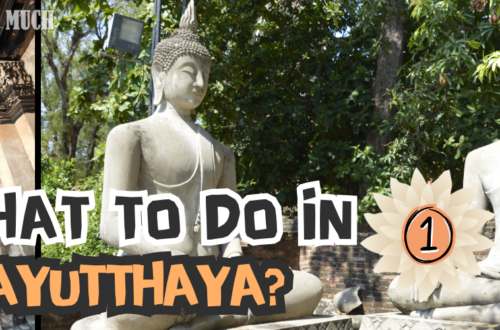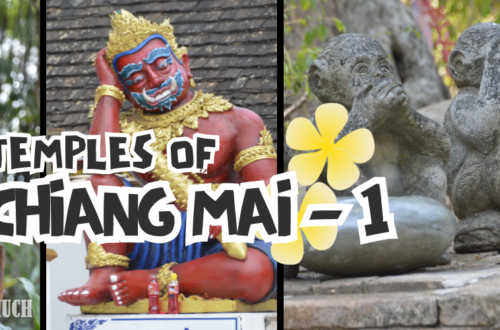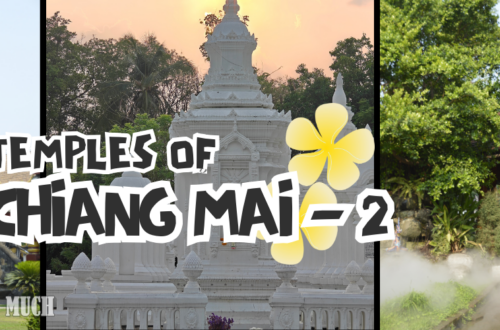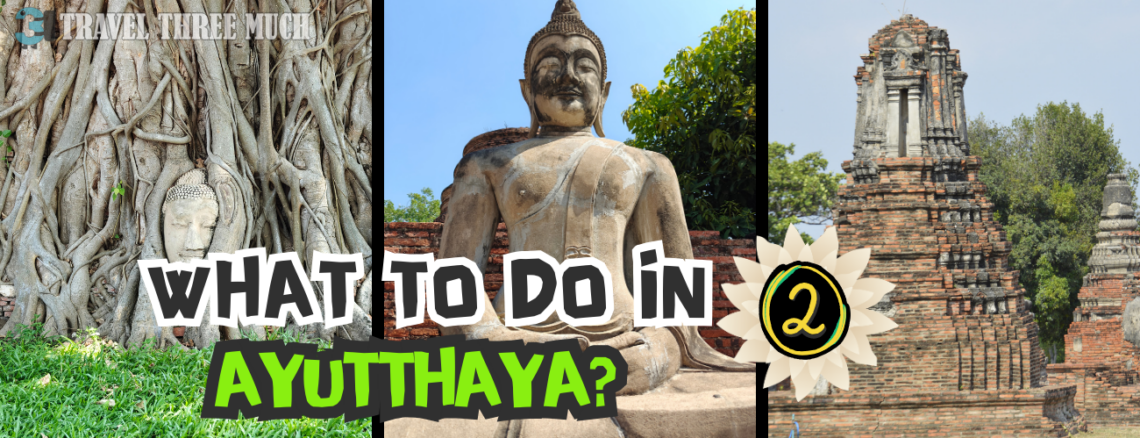
Ayutthaya – Whispers of Yesteryears – Part 2
This is the second part of our blog on Ayutthaya. If you haven’t caught up on the first part yet, head over here.
Read first part of our Ayutthaya journey here.
After the idyllic time at Wat Lokkayasutha and Wat Worachettharam, it was time for us to visit the central complex of monuments, collectively called the Ayutthaya Historic Park.
Wat Phra Ram
Our first stop was Wat Phra Ram. This is a monastery constructed on the cremation site of King Ramathibodi I, the founder and first ruler of the Ayutthaya kingdom. Entry to the monument costs 50 THB per person and is free for Thai citizens and children.
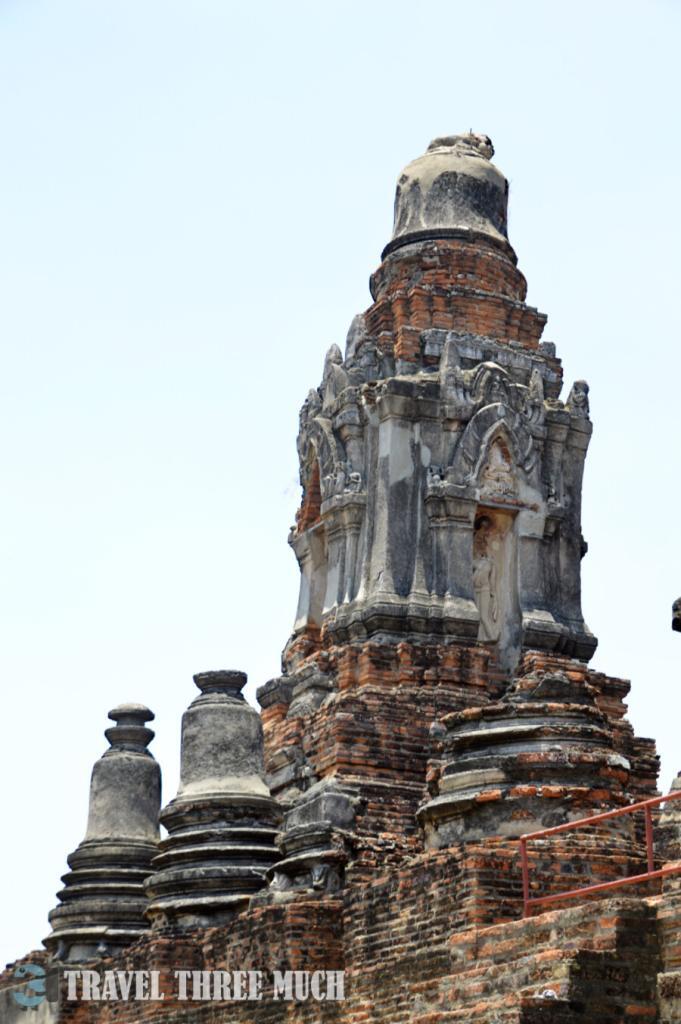


The monument is open from 8:00 AM until 6:30 PM on all days. We encountered a set of three small chedis on a lawn. The pathway led us to some more chedis and finally, a small pond at the rear of the complex. From here, we could see the remains of the vihan. We also saw a couple of birds for the first time – an Indian Roller and a Pacific Reef Heron on the banks of the pond. The Indian Roller’s bright blue and purple hues were eye-catching. The reef heron’s drab grey form, as it remained perfectly still, scanning for prey, made it seem like a small rain cloud floating on stilts above the pond.
Just past the vihan, we came to the Khmer-style central prang, surrounded by four smaller prangs on a square platform. Wat Phra Ram is one of the first temples of Ayutthaya. It follows the Khmer school of architecture in its construction. We made our way to Wat Phra Si Sanphet, next.
Wat Phra Si Sanphet
Ayutthaya’s principal temple, Wat Phra Si Sanphet was situated within the kingdom’s Grand Palace grounds. Entry fee to the temple is 50 Thai baht per person. There is no entry fee for Thai citizens and children. Just past the entry gate, we immediately come face-to-face with the three chedis and the mandapas. These serve as reliquaries for the remains of three of the monarchs of the Ayutthaya kingdom – King Ramathibodi II, King Borommarachathirat III, and Borommatrailokkanat.

These are the only structures that survived the Burmese invasion in 1767 CE and the accompanying sack of the capital. We sat under a Bo(Sacred Fig or Peepal) tree on the monastery lawns for a while. We took in the splendid stucco work on the chedis and mandapas. It is said that a giant image of the Buddha in a standing posture, about 16 m tall and gilt with close to 350 kg of gold, once served as the capital’s palladium at this monastery’s royal chapel.
Similarly, five Buddha images made out of gold, copper, and silver were commissioned and installed in the chedis and mandapas. The Burmese invasion wasn’t kind to Wat Phra Si Sanphet’s treasures. Invaders stripped the gold from the chedis, mandapas, and even a giant Buddha statue, leaving only a damaged core behind. They hauled away the loot, leaving the once-gleaming temple behind. Some believe the massive Buddha head in Bangkok’s National Museum is from Wat Si Sanphet.

We finished walking around the central chedis and reached the remains of the viharns. From here, we could see a board that indicated the presence of other points of interest such as three different Throne Halls and the Royal Palace. I walked around for a bit but could find nothing other than the traces of the outer walls of these structures with information boards indicating the spaces they would’ve occupied. Today, other than the remains of the foundations of the buildings, and the outer walls in a few places, nothing else remains of the Grand Palace complex. The Fine Arts Department built a scale model of the city, using their studies of documents and past excavations to bring Ayutthaya’s grandeur back to life. The model gave an idea of the impressive scale and grandeur of the city in its heyday.
We exited Wat Si Sanphet and had some iced tender coconut (called Young Coconut in many places in Thailand) to beat the heat. The Wihan Phra Mongkhon Bophit, famous for its giant gilt Buddha image in the seated position, is right outside the Wat Si Sanphet entrance. We didn’t visit the wihan on this trip. The Royal Kraal and Elephant Stables are nearby, where the elephants and their keepers can be hired for 20-minute rides and photos. We gave this a miss because we had many opportunities to see elephants in the wild back home, and the potential for animal abuse did not sit well with us. Our next stop was one of the most photographed places in Ayutthaya – Wat Maha That.

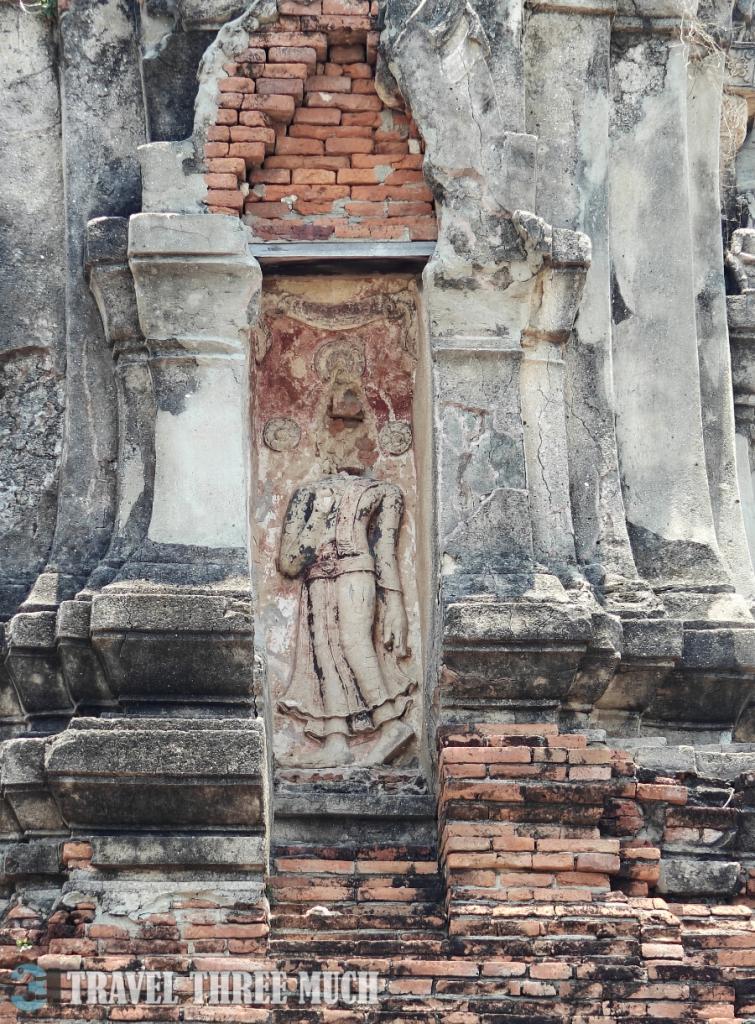
Wat Maha That
Entry to Wat Maha That is 50 Thai baht, free for Thai citizens and children. Wat Maha That remains open from 8:00 AM to 5:00 PM on all days. The entrance gate led to a pathway on the side of the temple, laid out along the East-West directions. We took a right turn on the path, past a row of chedis, to reach what’s probably the most photographed object in all of Ayutthaya.
It was a Buddha’s head in the roots of a Bo tree, which has become a symbol of Ayutthaya. There was an area reserved in front of the Buddha’s head for tourists to take pictures with it, and a guard to ensure propriety in the presence of the Buddha was followed. Specifically, standing taller than the Buddha’s head is a strict no-no as it is considered disrespectful. So, be mindful of this when taking pictures. There was a ‘satellite’ vihan, past the tree roots, with a Buddha seated in front of it. As most of the crowds were drawn to the Buddha’s head, this was a relatively calmer area.


We took a break from the afternoon sun thanks to the trees above. The contrasting deep greens with the rich ochre shades of the brickwork only broken by the white plaster of the Buddha image and the golden wrap over the shoulder, and a gentle breeze cooling us off, all made us pause and lose track of time. While the Buddha was seemingly resonating his timeless message of this too shall pass.
Just past this vihan is the remnant of the main prang’s base. The main prang, once a towering structure, is now a sad reminder of the importance of preserving historical sites.
Time and neglect haven’t been kind to Wat Maha That’s central prang. Once a towering structure, today only the staircases leading to its base and scattered brickwork remain. This collapse in the early 20th century serves as a stark reminder of the importance of historical preservation.
Despite the missing centerpiece, Wat Maha That offers a glimpse into Ayutthaya’s past glory. The surrounding galleries showcase rows of headless Buddha statues, a silent testament to the large scale destruction the site endured.
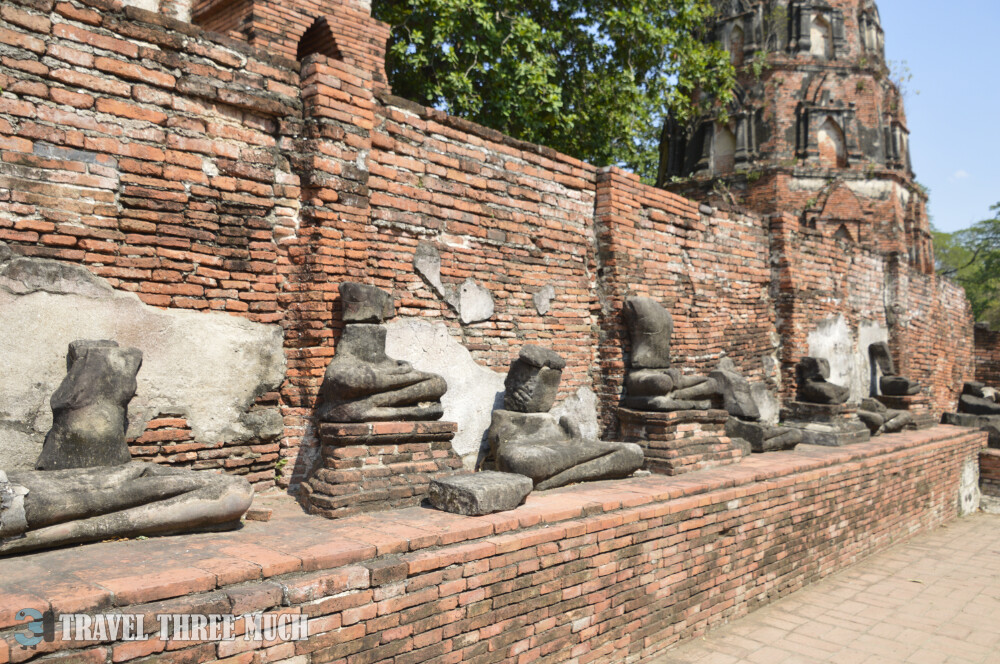
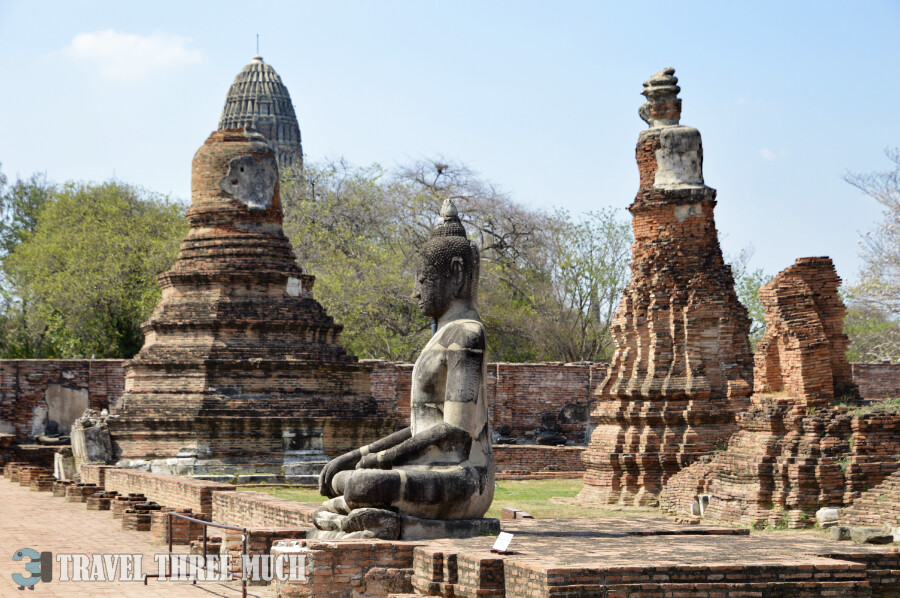
The Thai name of this temple translates to The Temple of The Great Relic. The name likely references Buddha’s relics, excavated in the 20th century. These are on display at the Chao Sam Phraya Museum in Ayutthaya. The museum also has other artifacts recovered from excavations in Wat Maha That and Wat Ratcha Burana. The museum is worth a visit if you’re a history buff or wish to learn more about the Ayutthaya kingdom’s rise and fall.
Wat Ratcha Burana
Our last destination for the day was Wat Ratcha Burana, next door to Wat Maha That. Wat Ratcha Burana is open from 8:30 AM to 5:00 PM. The entry fee is 50 Thai baht per person and no charges for Thai citizens and children. The main prang, visible from the entrance, stood as a testament to Khmer architectural influence, much like the earlier temples. Built in 1424 CE, Wat Ratcha Burana honors the memory of two royal brothers who died in a fight for the throne.
Just past the main entrance is the royal vihara, aligned on the East-West axis with the main prang. The construction style is Khmer, as are most of the older Ayutthaya monuments. Only the side walls and a few pillars of the vihara remain. A portion of the vihara extends into the gallery surrounding the main prang.
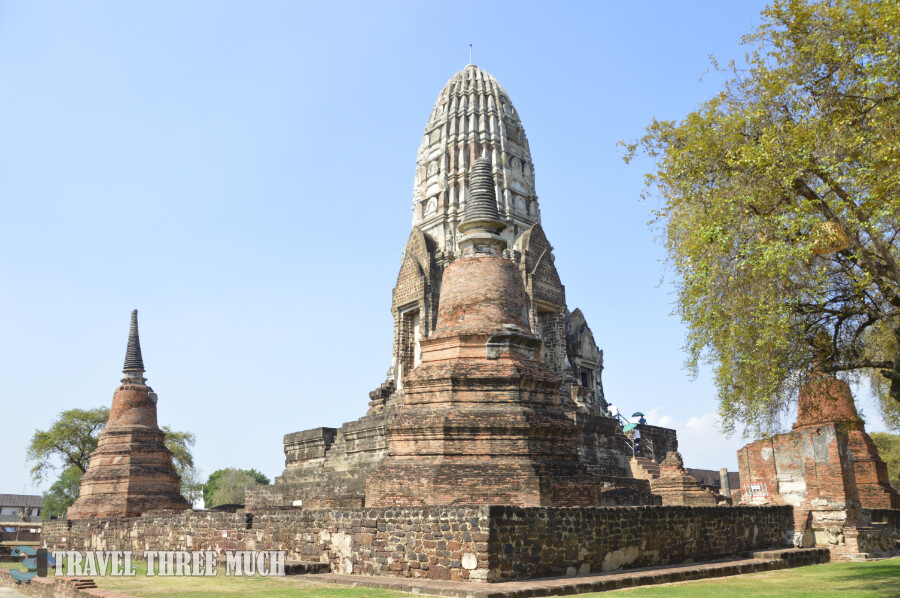
We walked up a short flight of stairs to the first level of the prang. The prang has Garuda sculptures at the base, as well as on the tower. Another longer set of steep stairs leads up the side of the prang to the top. From here one gets panoramic views of the Wat’s grounds. The Ordination (Ubosot) hall with some portions of the side walls, a portion of the altar, and a couple of pillars are also visible from the top. When we visited, we couldn’t access the two-level crypt where the princes were once interred. The excavated relics are in the Chao Sam Phraya Museum. Only the murals on the walls of the upper and lower chamber are supposedly still in the Wat.
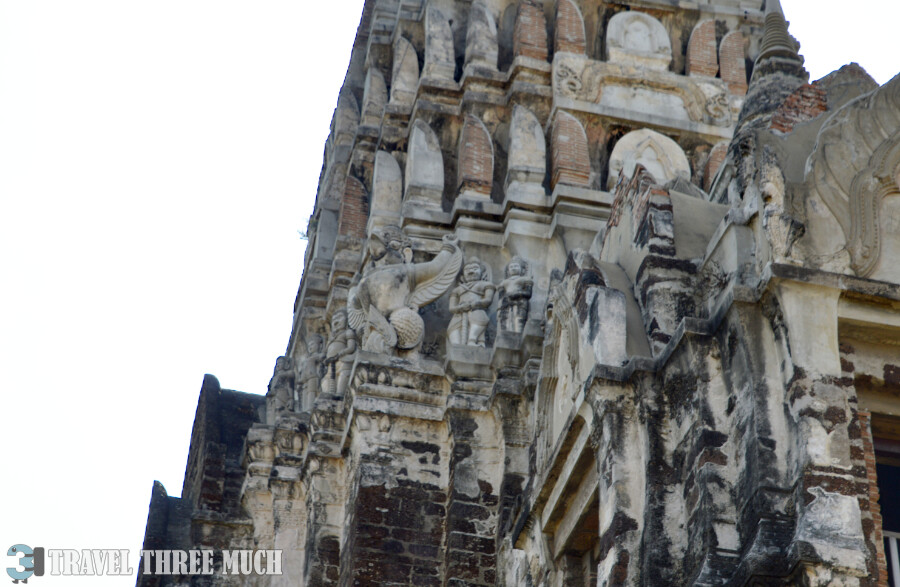

After our historical exploration, we indulged in a sumptuous lunch at Burana Ayutthaya Cuisine. The Pad Thai and Pesto Spaghetti, followed by creamy coconut smoothies, provided a perfect end to our day.
As we departed, we carried with us vivid memories of Ayutthaya’s ruins. It stood as a testament to a dynasty that achieved remarkable heights in art, economics, and society, only to fall to the very vices the Buddha warned against.
Ayutthaya wasn’t just sightseeing, it was a journey into Thailand’s soul. The ruins whispered of a glorious past, reminding us of impermanence – a powerful message that stays with us.
